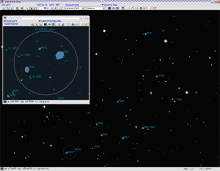Sometimes things go badly. It may turn out that all the pieces aren't yet in place to really make it work, or that some unexpected development has left the whole idea lame and unworkable. Sometimes I just can't make it all come together to my satisfaction.
But most of the time a new idea soars. I try my best to let it do that, allowing for major changes and redesigns right up to the last minute. Having a sound design going in is very important, but I've found that the best tools evolve in ways that I can't imagine ahead of time. I see it as my job to let them do so. I simply try to hang on for the ride and when we land see where it all ended up. And here we are...

All-in-all I'm very happy with it and the test team is all thumbs up! Most of the concerns I had going in have been worked around to my satisfaction and there were some pretty cool developments along the way. One of my favorites is in the Shallow Sky auto-generated list. Among other things it looks for any fast-moving minor planets that may be visible that night. Another really cool one is in the Interesting Stars feature. As part of its function it looks for eclipsing variable stars with deep eclipses and only lists those that are predicted to be in eclipse that night. Very cool.
Another thing I really like is the ability to prune the list to a small set of randomly selected objects. I enjoy knowing that every time I create an auto-generated list of NGC/IC objects it will give me a unique set of targets for that night. There are so many galaxies and clusters available in my 18-inch. It's like closing my eyes and putting my finger on the atlas to pick my targets. Who knows what I'll find there. Yet with this tool I can be assured that the object will be a reasonably good target that is appropriate for my telescope.
Perhaps the most useful auto-generated list is the one that spawned the idea in the first place: the Showpieces listing. I've already used it myself when I had to be at a star party with very little time to prepare. Recommended targets included the setting moon, Mars, comet 17P Holmes, several nice double stars, and a good assortment of deep sky objects of various types. Planning doesn't get any easier than that!





